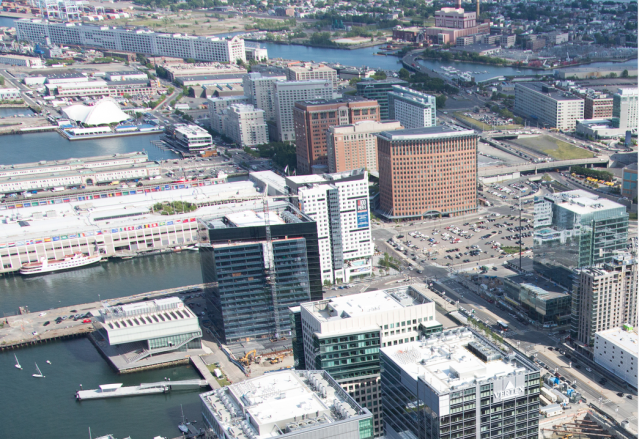
Easterly part of Boston Innovation District, with the very long Design & Innovation Building, on Northern Avenue, at upper left. (Boston Planning and Development Agency)
Last week I attended a party on Tide Street in South Boston, part of the Hub’s Innovation District. The party was fun, but please let me convey my experience of the district’s urbanism as a warning to Providence, which seems to want to reproduce it, albeit writ small, along the Route 195 corridor in what our city and state hope will become its own innovation district.
I left the party around 7:30 after phoning for a cab, and waited for the cab next to Tide Street, near Drydock 3. The street was long, wide, straight and empty. After 20 minutes the cab had not come. It was getting dark. I called the dispatcher, who said the cab would be right there. Another 20 minutes and I set out for Northern Avenue, some 300 yards off, an extension, even longer and wider than Tide, of the district’s main drag, Seaport Boulevard. Still, almost no cars. Reaching Northern, I crossed to a mammoth industrial facility, built in 1918 by the U.S. War Department, now the Innovation & Design Building. (Its western end is anchored by the Boston Design Center, where the New England chapter of the Institute of Classical Architecture & Art now meets.) No cars, no people. I tried to find where to go in. But before reaching it, I finally saw and flagged down a cab. As if we were back in Rhode Island, with its 1½ degrees of separation, the cabbie had been looking for me for at least half an hour, and kindly took me to South Station.
This sort of thing can happen anywhere, of course. The point is that the environment was way out of human scale, with nothing nice to look at. It was lonely out there and I felt like a small rodent. I was grateful it was dark, for, although there are lovely old blocks on the way into the district along Congress Street, out here and in much of the district, night graciously cloaks buildings that by day make some of us wish we were blind. All was emptiness and sterility, nothing intimate or comforting to the eye. The level of street activity, pedestrian or motorized, makes Westminster Street seem as bustling as Fifth Avenue. The architecture of Boston’s Innovation District makes our Jefferson Boulevard seem as lovely as London’s Regent Street.
Now Providence and Rhode Island are building their own innovation district. There is no law that our district’s appearance cannot be inspired by the brick mill architecture that housed the Jewelry District when its innovators led global industry in some fields. Or some other style that strengthens our beauty and historical character. But there is a law – the Providence Zoning Code – that says new architecture in downtown (which the 195 corridor now is, officially) must be “compatible with the existing historic building fabric and the historic character of downtown.” (See “Battle of the 195 riverfront.”)
This is a really easy decision. Let’s not muff it, please. A very robust Boston can afford to stink up part of the city. Providence cannot.
By the way, the principles involved apply equally to Providence’s Amazon pitch.

About a third of the length of the Innovation & Design Building, into which a new Reebok headquarters is moving this fall. (Boston Business Journal)



Pingback: Dejeweling the Jewelry District | Architecture Here and There
Were you at Tide 7 – the new Sub-Zero/Wolf design showroom?
LikeLike
Gross..like most things in Boston. I am confident that Providence will be vigilant if it wins.
LikeLike
I wish I had your confidence about Providence’s vigilance, Steve. It hasn’t shown any lately. As for gross things in Boston, yes, they are everywhere. But what about Beacon Hill? What about Back Bay? What about the Public Garden and the Commons. What about the Post Office Tower? What about many other places in Beantown? Surely you jest!
LikeLike
Ha!! I do not fully jest. While the areas you mention are nice, I counter with the many – too long to list – significant ugly aspects of the place. My point is that Boston’s negatives far outweigh its positives. We are still weighed on the postive side and our basic attitude favors a more thoughtful consideration of developmental design.
LikeLike
I agree with your first point, Steve, but not your second. How do you see the fact that our positives outweigh our negatives (that is, we’ve still got a preponderance of beauty) leading to a more thoughtful consideration of development design. We still have beauty, yes, but we’ve been throwing it away for decades. Downtown Providence 1970 (read my book) would have destroyed our city. Luckily, inertia and lack of money stopped that. But almost every new building since then has been ugly, and now what’s happening in the 195 corridor is doubling down on Downtown Providence 1970. As of now all we can be sure of is that our basic attitude does NOT favor a more thoughtful consideration of developmental design. I wish it were not so, but every evidence says so – and it is because politicians and their bureaucrats (in the developmental agencies) refuse to embrace the taste of the average worker, the average voter. I’m not sure how to get the average worker and the average voter to deliver the message that must be delivered, but that’s what has to be done – and only then will our basic attitude be reversed and finally make developmental progress that will strengthen rather than weaken the brand of Providence and of Rhode Island.
Well, Steve, I’ve gone on too long, but I hope you see my point. No, sadly, I do NOT trust our leaders to consider things thoughtfully.
LikeLike